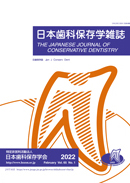Volume 65, Issue 1
Displaying 1-9 of 9 articles from this issue
- |<
- <
- 1
- >
- >|
Reviews
-
2022 Volume 65 Issue 1 Pages 1-8
Published: February 28, 2022
Released on J-STAGE: March 01, 2022
Download PDF (684K) -
2022 Volume 65 Issue 1 Pages 9-20
Published: February 28, 2022
Released on J-STAGE: March 01, 2022
Download PDF (10755K)
Mini Reviews
-
2022 Volume 65 Issue 1 Pages 21-24
Published: February 28, 2022
Released on J-STAGE: March 01, 2022
Download PDF (2008K) -
2022 Volume 65 Issue 1 Pages 25-29
Published: February 28, 2022
Released on J-STAGE: March 01, 2022
Download PDF (2628K)
Original Articles
-
2022 Volume 65 Issue 1 Pages 30-37
Published: February 28, 2022
Released on J-STAGE: March 01, 2022
Download PDF (1413K) -
2022 Volume 65 Issue 1 Pages 38-46
Published: February 28, 2022
Released on J-STAGE: March 01, 2022
Download PDF (2107K) -
2022 Volume 65 Issue 1 Pages 47-55
Published: February 28, 2022
Released on J-STAGE: March 01, 2022
Download PDF (13275K) -
2022 Volume 65 Issue 1 Pages 56-63
Published: February 28, 2022
Released on J-STAGE: March 01, 2022
Download PDF (324K) -
2022 Volume 65 Issue 1 Pages 64-77
Published: February 28, 2022
Released on J-STAGE: March 01, 2022
Download PDF (394K)
- |<
- <
- 1
- >
- >|
